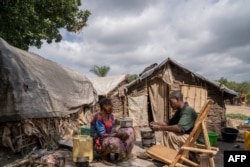A record 75.9 million people are living in internal displacement due to conflict, and nearly half that number is in sub-Saharan Africa, according to a recent report.
The report from the Internal Displacement Monitoring Centre, or IDMC, shows 34.8 million people in the region were displaced in 2023, up from the previous year. The biggest increase came in Sudan, which is currently in the midst of civil war.
Sudanese doctor Aisha Hassan is among the millions of people newly displaced last year.
The doctor said that when she arrived for work at a hospital to tend to those injured in the country’s ongoing civil war, she faced threats from the paramilitary Rapid Support Forces and gangs. The RSF has been at war with the Sudanese armed forces since April of last year.
The threat forced her to leave her patients and her city, Omdurman, northwest of the capital, Khartoum. Hassan said she and her family fled to safety.
"From there I went to North Sudan Al-Shimaliyya, it's called Karima. We stayed there for three months, and my family and I went to Port Sudan. From there we displaced here to Uganda," she said.
Fighting between the Sudanese armed forces and the RSF has displaced 9.1 million since April 2023, making Sudan the country with the most displaced people globally. According to the IDMC, the number marks “the most ever recorded in a single country since records began in 2008.”
The conflict has made it difficult for aid agencies to reach the millions in need, triggering more displacement as people search for food, water, medicine and safety.
Elsewhere, fighting in the Democratic Republic of Congo between the army and rebels has displaced close to 7 million people. Conflict in Ethiopia that began with a two-year war in Tigray in 2020, and erupted in many parts of the country, displaced 790,000 people last year.
Africa's conflicts are usually over territory, community politics, and control over resources, with at least 10 African countries, predominantly in West Africa, dealing with terrorism-related conflicts.
Burkina Faso is the most affected of the West African countries, with 700,000 people displaced last year, up 61 percent from 2022.
"A rising conflict is really contributing to the rising trend, and especially weather-related disasters, including floods, storms, and drought, are also contributing to pushing the figures to an all-time high,” said Vicente Anzellini, coordinator and lead author of the IDMC report. “So all of this is really a concerning trend. It's important to underscore, however, that governments and humanitarian actors are taking more action and are producing more data. And this, of course, influences the trend."
Anzellini said governments need to improve their capabilities to resolve conflicts and cope with natural disasters.
"What we're really seeing in the region should be a reason for concern and more efforts need to be put in conflict resolution, of peace building, and disaster risk reduction across this region to reduce the trend that, again, highly influences the global trend,” Anzellini said. “So if internal displacement is addressed and reduced in Africa, the global trend will also successfully reduce. And it's unfortunately not a trend that we're seeing in the last couple of years. And for this to happen more government leadership and investments will be needed."
The Swiss-based agency says the overwhelming majority of the displaced stay in their own countries as they struggle to survive and rebuild their lives.
For Hassan, it was too dangerous for her to stay, as armed groups started to loot her family’s home while she was working in the hospital in Sudan.
"After two months or so, the Rapid Support team came and resided in our home,” she said. “Now they are living in our home. I don't know how many of them there are, but they told us they are living there. They took my father's car, and they are living there."
The IDMC says no country is immune to disaster displacement and that conflicts in Sudan, the DRC, and the Palestinian territories drove up the number around the world.










